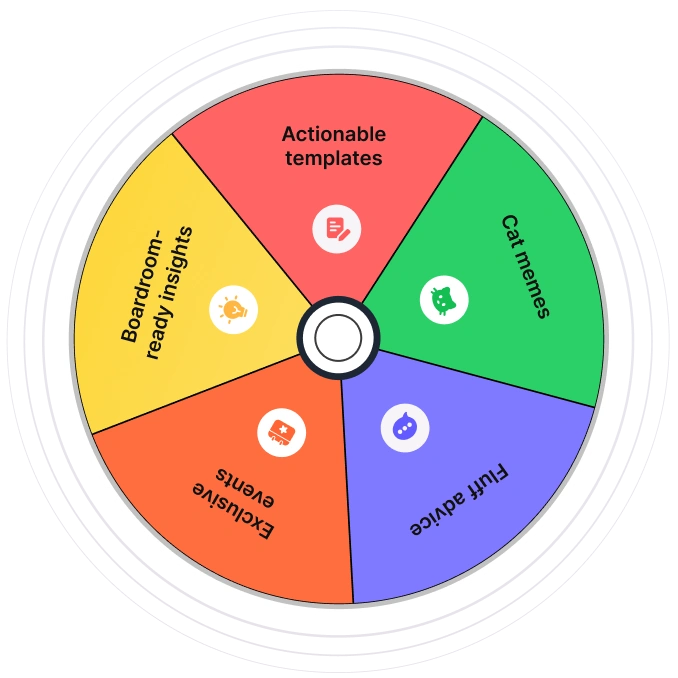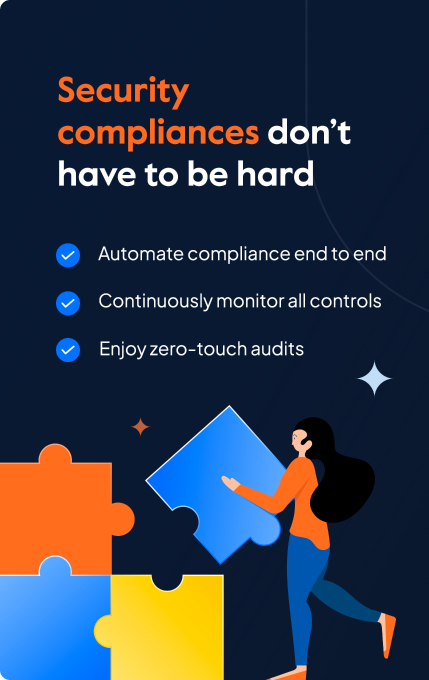According to the AICPA, demand for SOC 2 reports is up nearly 50%, and more companies are taking a hard line: no report, no deal. Consequently, risk teams have tightened their vendor-assessment checklists. Buyers also want a fresh PDF certifying that your services are secure, not promises that the audit is “in progress.”
If you’re trying to land bigger contracts or build trust with security-conscious customers, a SOC 2 audit is the indispensable signal that your business takes data protection seriously and can prove it.
This guide lays out what a SOC 2 audit involves, what it proves to the outside world, and how to go through the process without slowing your regular operations down.
📋 Quick Summary in 60 Seconds
Why a SOC 2 Audit Matters:
- Proves your organization’s security, privacy, and availability controls work as designed.
- Builds customer trust and unlocks enterprise deals where SOC 2 is mandatory.
- Demonstrates operational maturity and ongoing compliance readiness.
Challenges in the Audit Process:
- Lengthy evidence collection and remediation cycles.
- Complex scoping and documentation requirements.
- Manual efforts increase risk of errors and audit delays.
How Sprinto Helps:
- Automates readiness, evidence collection, and control mapping.
- Keeps systems continuously compliant with SOC 2 trust criteria.
- Sprint through SOC 2 audits without slowing operations — Book a Demo with Sprinto!
What’s a SOC 2 audit?
A SOC 2 audit is an independent assessment that verifies whether your organization’s controls align with the TSCs: security, confidentiality, processing integrity, privacy, and availability of data. These Trust Services Criteria are defined by the AICPA and falls under the System and Organization Controls framework. It focuses on how well your policies are designed and whether they work in practice over time.
A SOC 2 audit inspects your internal controls: how you manage data, control access, onboard employees, handle incidents, and maintain operational discipline. While the audit examines these operational controls, it evaluates each one against the relevant TSC domain to confirm it mitigates the risks the criteria describe. The scope includes your governance structure, documented processes, and actual behavior.
Note
Because SOC 2 is a principles-based framework, auditors interpret how your specific controls map to the criteria and decide what constitutes sufficient evidence.
For instance, if your policy says all laptops are encrypted, they’ll ask for a sample of device IDs and request screenshots or logs proving encryption. If you claim monthly access reviews happen for high-risk systems, they’ll want to see dated records showing those reviews took place.
So why go through it at all? Let’s look at why it matters.
What’s the purpose of a SOC 2 audit?
Having a SOC 2 report is how you show customers, partners, and regulators that your security controls are in order. It exists to solve a business problem: how do you prove you can be trusted with customer data? The report is the tangible proof.
87% of consumers would not do business with you if they have concerns about your security practices. The SOC 2 audit is a standardized, credible document that provides independently verified proof that your organization takes data protection seriously.
Here’s a breakdown of the main purposes of a SOC 2 audit:
- Radically reduce sales friction: Many SaaS vendors see deals stall during protracted security reviews. A SOC 2 report pre-answers most security, compliance, and risk questions, shortens the sales cycle, and reassures prospective buyers.
- Acts as a forcing function for maturity: The audit process drives continuous improvement to move teams from informal workflows to formally documented and consistently executed procedures. It leads to accountability, transparency, and embeds security discipline into day-to-day operations.
- Protects the brand: A clean SOC 2 report instantly helps with credibility and often becomes the clincher for security-conscious clients. The strong internal controls required by the framework also reduce the long-term risk of data breaches.
- Satisfies regulatory and contractual demands: SOC 2 has become almost compulsory in fintech, healthcare, and other regulated sectors. Its controls overlap with ISO 27001, HIPAA, and GDPR and allow organizations to cover multiple compliance obligations through one focused effort.
Who needs to go through the SOC 2 audit process?
The short answer is any service organization that handles, processes, stores, or touches customer data. But “service organization” is a broad term. To simplify, if a company’s technology and operations impact the security, availability, or confidentiality of customer data, then it must undergo a SOC 2 audit.
It’s not a legal requirement but a market-driven one. You typically need a SOC 2 report when your customers, especially larger, more mature enterprises, refuse to do business with you without one.
SOC 2 is best associated with SaaS companies, but extends to any B2B provider whose services are integral to their clients’ operations, like
- Infrastructure and platform providers (IaaS/PaaS): Companies like AWS, Google Cloud, and Azure undergo rigorous SOC 2 audits.
- Data center and colocation services: They physically house the servers and infrastructure for other businesses.
- Managed Service Providers (MSPs): Firms that manage IT, security, or network infrastructure for their clients.
- Payment processors and fintech companies: Any organization handling financial data is under immense scrutiny.
- Marketing and HR technology platforms: These systems handle sensitive customer lists (PII) or employee data.
What are the types of SOC 2 audits?
There are two types of SOC 2 audits, Type 1 and Type 2. Both are distinctly differently in the depth of what and how they assess.
SOC 2 Type 1 audit
A SOC 2 Type 1 audit focuses on the suitability of the design of your company’s controls. The auditor evaluates your security program, processes, and procedures to determine if they are theoretically sound and designed to meet the SOC 2 criteria.
The scope is a single point in time, “as of” a specific date. They are attesting that on that particular day, your controls were designed and implemented properly. With controls already documented and operating, a SOC 2 Type 1 report typically takes about four to six weeks to complete.
The Type 1 report is a starting point. It shows that you have designed and established a security program. Use this if you’re new to SOC but don’t yet have the months of evidence for a Type 2.
SOC 2 Type 2 audit
A SOC 2 Type 2 audit evaluates both the design of your controls and their operating effectiveness. Auditors test to see if controls have been functioning as they should.
The scope is a period of time, typically between 6 and 12 months. The auditor examines evidence collected throughout this entire window to verify that your controls were operating as intended, day in and day out.
This audit offers a much higher level of assurance and is what most customers and partners want to see.
| SOC 2 Type I | SOC 2 Type 2 | |
| Main question answered | Are your security controls designed properly? | Do your security controls actually work consistently over time? |
| Focus | Evaluates the design of your controls at a single moment. | Evaluates the effectiveness of your controls over a period. |
| Time period | A snapshot on a specific date | A window of time, usually 6-12 months |
| Auditor role | Reviews policies and confirms controls are in place. | Reviews policies, confirms controls are in place, and then tests samples of evidence from the entire period to see if they worked. |
| Level of assurance | Moderate. | High. |
SOC 2 audit scope
The SOC 2 scope has two components. The first is defining the system or service being audited, which includes products, infrastructure, and teams. The second, and more important, is selecting the Trust Services Criteria (TSC) to be included.
Here are the five TSCs you need to know about:
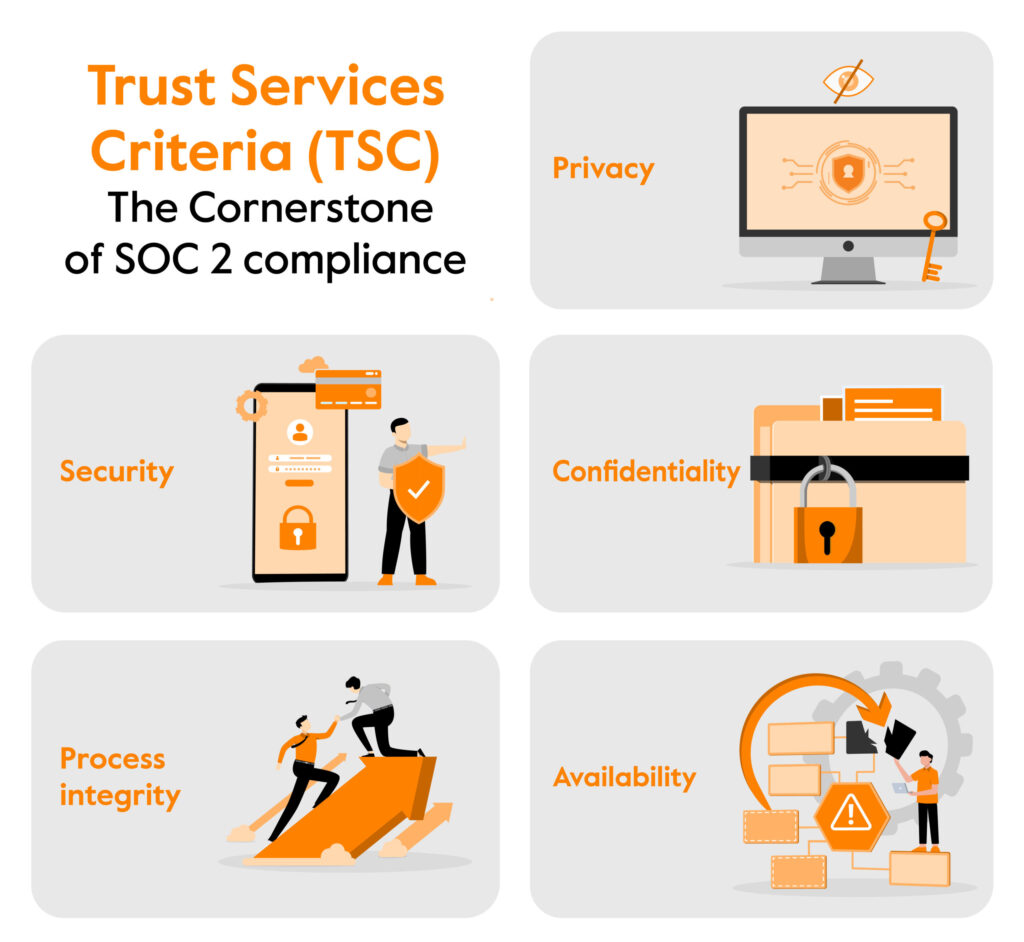
- Security (Required): The bedrock of every SOC 2 engagement, Security addresses safeguards like firewalls, MFA, and vulnerability management that prevent unauthorized access, misuse, or modification of systems and data. Regardless of industry or size, an organization cannot issue a SOC 2 report without meeting this domain.
- Availability (Optional): Chosen by providers who commit to strict uptime or disaster-recovery objectives. Controls focus on capacity planning, fault tolerance, backups, and incident‐resolution SLAs. It’s a common add-on for cloud infrastructure, SaaS, and critical B2B services.
- Confidentiality (Optional): Required when the service handles proprietary or otherwise sensitive business information such as legal documents, source code, or intellectual property. Encryption in transit and at rest, granular access controls, and data-retention rules are key controls.
- Processing Integrity (Optional): Relevant to platforms that perform calculations, transformations, or transactions where accuracy and completeness are paramount (e.g., fintech apps, payroll engines, tax-filing software). Controls cover input validation, error handling, reconciliation, and quality assurance testing.
- Privacy (Optional): Appropriate for services that collect or store personal data subject to regulations such as GDPR, CCPA, or HIPAA. Controls focus on notice and consent, purpose limitation, data-subject rights, secure disposal, and breach-notification procedures.
SOC 2 audit readiness assessment
The SOC 2 readiness assessment is a systematic, top-to-bottom review of your current environment mapped against the specific SOC 2 Trust Services Criteria you plan to include in your scope.
The goal is simple—to identify every single gap between your current practices and what an auditor will expect to see long before they walk in the door.
A good readiness assessment produces a detailed gap analysis report. It specifies exactly which controls are failing, why they are failing, and the evidence you’ll need to produce to prove you’ve fixed them. If you’re unsure of where to begin, here’s a pre-built self-assessment catered to SOC 2:
Down your assessment template
Coming up with a SOC 2 remediation plan
The next step is to create an action plan with the gaps identified from the readiness assessment and the scope defined. The SOC 2 remediation plan is a detailed, project-managed effort to close every identified gap, build new controls where they are missing, and generate the evidence an auditor needs to see.
Each remediation task should have a clear owner responsible for its completion, a specific deadline, and a definition of what done looks like.
For instance, if your risk assessment process has a gap, you have to task it with tasks like developing a risk assessment methodology, conducting the company-wide risk assessment, and securing management approval of the results by Q3.
This plan builds the foundation of a compliant program. Now, let’s see how you do the audit.
The SOC 2 audit process (Explained in steps)
Your SOC 2 audit needs to be a well-defined project that moves from high-level planning to granular evidence review. Here are the steps you can expect once you’ve completed your readiness work:
Step 1: Source and select your auditor
SOC 2 reports can only be issued by a licensed CPA firm, so the first task is to identify audit partners who
(a) Specialize in SOC 2,
(b) Understand cloud-native environments like yours, and
(c) Can commit to a realistic timeline and budget.
Vet each candidate’s peer-review record, methodology, and industry references.
If you’re using a compliance platform such as Sprinto, you can tap its pre-vetted auditor network of firms that already understand the platform’s data feeds, and cut weeks of back-and-forth during scoping.
Step 2: Audit kickoff and planning
You’ll meet with the audit team to finalize the practical details of the project. Here, you confirm the audit’s scope (which TSCs are included), the audit period for the report, and the key timelines for evidence submission and fieldwork.
During this phase, you will provide the auditors with your core set of documentation, including your system description, key policies, and the list of controls you’ve designed. This gives them the roadmap they will use for the rest of the audit.
Step 3: Evidence request and collection
Shortly after the kickoff, you will receive the first, and typically most substantial evidence-request list from your auditors. The list is an exhaustive and specific inventory of required proofs. Your team’s primary task during this phase is to gather and upload evidence to the auditor’s secure portal.
Manually chasing these artifacts by pulling logs, screenshots, and tickets into worksheets can take months and drain engineering bandwidth. Compliance-automation software as Sprinto plugs directly into your cloud and SaaS stack, auto-collects real-time evidence and pipes it into an auditor dashboard so both sides work from the same live data.
Step 4: Auditor fieldwork and testing
Fieldwork is the audit’s main event, though it’s almost always conducted remotely now. During this phase, the auditors investigate the evidence you’ve provided. They operate on a principle of sampling to test the operating effectiveness of your controls (for a Type 2 report).
They will select random samples from the populations you provided, like new hires, system-change tickets, or terminated employees, and perform detailed testing on that sample to verify your controls worked every time.
It’s an interactive phase; expect a lot of follow-up questions and requests for clarification.
Step 5: Addressing exceptions
If auditors find control failures or “exceptions”, you get a brief window to remediate the root cause or document a management response.
Minor exceptions may only need extra evidence; bigger ones could trigger control redesign or a modified opinion. Prompt, transparent fixes show a culture of continuous improvement and often satisfy the audit team without delaying issuance.
Step 6: Draft report review and management assertion
Once the auditors have completed their testing, they compile their findings into a draft report. They provide this draft so you can check it for factual accuracy and confirm that they have correctly described your company, technology stack, and systems.
At the same time, you will be asked to provide a “management assertion” letter, a formal document signed by leadership stating that you are responsible for the design and operation of the audited controls.
Step 7: Final report issuance
After your team has reviewed the draft and returned the signed management assertion, the audit firm issues the final, signed SOC 2 report.
This document contains the auditor’s opinion, the management assertion, a detailed system description, and the results of control testing. It’s the attestation you can now share with customers, prospects, and partners.
Tips for a successful SOC 2 audit
Don’t expect a perfect SOC 2 audit with a last-minute scramble. You’re building the framework for building a durable, ongoing security program. The final report is simply the byproduct of a well-run operation. It’s the process that matters. Here’s how you get the most out of the audit:
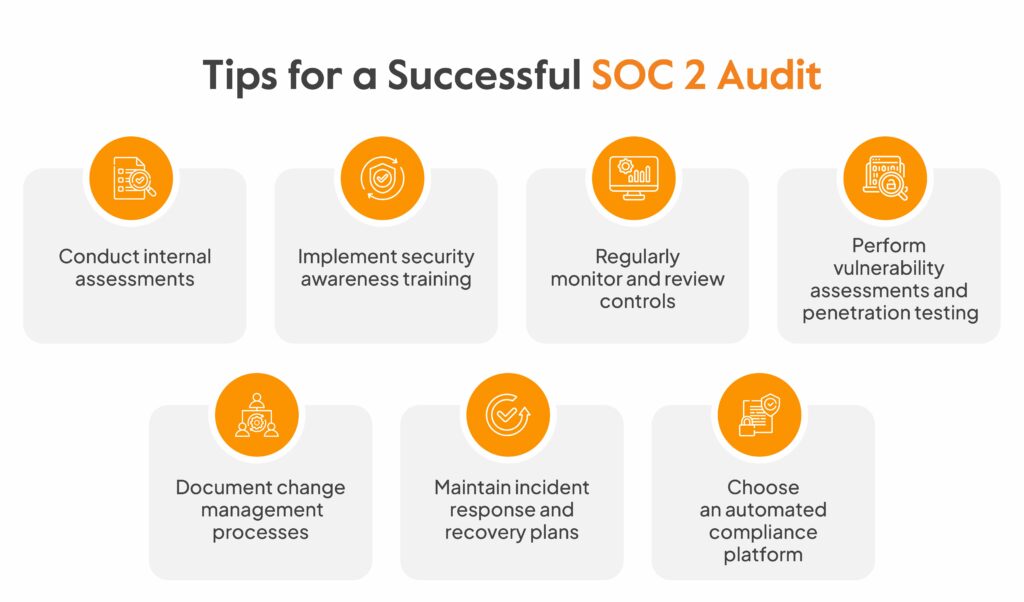
1. Conduct internal assessments
Before you pay a CPA firm for a formal audit, you need to know where you stand. A thorough internal assessment, or readiness assessment, is the single most important preparatory step you can take.
This is a full-scale simulation of the real audit, where you meticulously review your current practices against every single SOC 2 criterion in your scope. You are intentionally looking for the gaps, weaknesses, and areas where you lack sufficient evidence.
Make sure that the process produces a detailed gap analysis that becomes your remediation guide.
Sprinto, a compliance automation platform, takes the heavy lifting out of internal assessments by automating control checks, evidence collection, and policy enforcement across your cloud environment. Instead of manually tracking compliance tasks or chasing teams for documentation, Sprinto continuously monitors your systems, flags control gaps, and generates audit-ready reports in real time.
2. Implement security awareness training
Many SOC 2 controls are procedural and technical, but a lot hinge on your people. Your employees are your first line of defense, and auditors know this. That’s why you need a strong security awareness training program.
Auditors will want to see evidence that this training actually happens and that employees understand it. You’ll have to keep records of who completed the training and when. It also means conducting periodic phishing simulations to test whether the training is effective.
3. Regularly monitor and review controls
You must have documented proof that you are continuously monitoring your security posture.
You’d be performing periodic user access reviews to ensure former employees have been de-provisioned and that current employees only have the access they need to do their jobs. You’ll also regularly review system logs, firewall rules, and system configurations to detect anything suspicious
An auditor will specifically ask for the evidence of these reviews.
4. Perform vulnerability assessments and penetration testing
You can have hundreds of well-designed controls, but if there’s a technical vulnerability in any one application or network, you are still at risk. SOC 2 mandates that you have a formal process for identifying and managing vulnerabilities. You have to satisfy this with vulnerability scanning and penetration testing.
Vulnerability scanning should be an automated process that constantly scans your environment for known security flaws. A penetration test is a more focused, manual effort where security experts try to breach your defenses.
| Sprinto’s Vulnerability Management module provides real-time vulnerability tracking by integrating with multiple security scanners. While automated scans detect many common issues, Sprinto also helps you cover deeper attack scenarios. It integrates with pentesting tools and can connect you with qualified pen-test experts for more exhaustive testing. |
5. Document change management processes
Auditors need to see that you have an enforceable process for managing changes to your production environment. An undocumented change is an uncontrolled change, and it represents a significant risk.
Your change management process ensures that every modification, be it a small code push or an infrastructure update, is proposed, reviewed, tested, and approved before being deployed.
To satisfy this, you need an audit trail. You must be able to provide evidence for any change the auditor picks as a sample. This lives in a ticketing system like Jira, linked to your source control system like GitHub.
6. Maintain incident response and recovery plans
Despite your best efforts, security incidents can and will happen. A mature organization is judged not just on its ability to prevent incidents but on how it responds when one occurs.
SOC 2 requires you to have a documented incident response plan that details the steps your team will take in the event of a breach.
Alongside this, you need a disaster recovery plan to meet the Availability criteria. This plan describes how you will recover your service in the event of a catastrophic failure. Auditors will ask to see both of these plans.
7. Choose an automated compliance platform
Managing the hundreds of controls, evidence requests, and policies required for SOC 2 manually is a monumental task, even for a dedicated team. Spreadsheets and shared drives are prone to human error. It’s wise to turn to compliance automation platforms.
That’s where tools like Sprinto give you pre-built policy templates, map your controls directly to SOC 2 criteria, and integrate with your tech stack to automatically collect evidence continuously. If you’re missing out on a huge efficiency boost without one of these.
What’s included in SOC 2 audits for service organizations?
Expect to see these in a SOC 2 Audit report:
- Auditor’s opinion: This is the main judgment from the CPA firm. In a Type 1 report, it checks if controls are properly designed at a point in time. In a Type 2, it also checks if those controls worked as intended over a set period.
- Management assertion: A signed statement from your leadership team taking responsibility for the control environment and confirming the accuracy of your system description.
- System description: Your team writes it and outlines what your service does, the people, processes, and technology behind it, and also the commitments you make to customers around security and reliability
- Tests of controls and results: This is the longest and most detailed part. It lists each control, the auditor’s testing methods, and the outcomes. This section provides the evidence that supports the auditor’s opinion.
Who performs a SOC 2 audit?
Only an independent, third-party Certified Public Accountant (CPA) firm that is licensed by the American Institute of Certified Public Accountants (AICPA) can perform a SOC 2 audit. The AICPA creates and maintains the SOC 2 framework, so it requires its own licensed members to be the arbiters of it.
This requirement of independence is absolute. The firm that audits you cannot be the same firm that helped you prepare. You can hire consultants to help you conduct a readiness assessment and remediate gaps, but your auditor must come to the table with no prior involvement in the design of your controls.
How much does a SOC 2 audit cost?
The cost of a SOC 2 audit typically ranges from $30,000 to $50,000, depending on several factors like your company’s size, the scope of systems audited, the Trust Services Criteria selected, and whether you’re going for a Type I or Type II report.
Type I audits generally cost between $5,000 and $25,000, while Type II audits, which involve testing over a period, can range from $7,000 to $50,000. Beyond the auditor’s fees, companies often face hidden costs such as staff time, policy creation, security tools, remediation efforts, and legal reviews.
How frequently does the SOC 2 audit take place?
A SOC 2 report is not a one-and-done lifetime achievement; you have to perform it annually.
A report from two years ago is useless for providing assurance to a potential customer today, as it offers no insight into your current security posture.
In the interim period between audits, if a customer asks for updated assurance, organizations provide what is known as a “bridge letter” or “gap letter.” This is a letter written by your management that attests that there have been no material changes to your control environment since your last formal audit.
Sprint through audits without breaking your stride with Sprinto
SOC 2 isn’t hard because the controls are complex; it’s hard because tracking proof across tools, teams, and months is a mess. Left to manual effort, it slows down your team and turns compliance into a nightmare.
Sprinto is built to remove all of this mess. It connects directly to your systems like AWS, Azure, GCP, Okta, Google Workspace, GitHub, HRIS platforms and continuously monitors your controls in real time. When a new hire joins, it automatically checks onboarding steps: account creation, access provisioning, security tooling, and logs timestamped evidence without you lifting a finger.
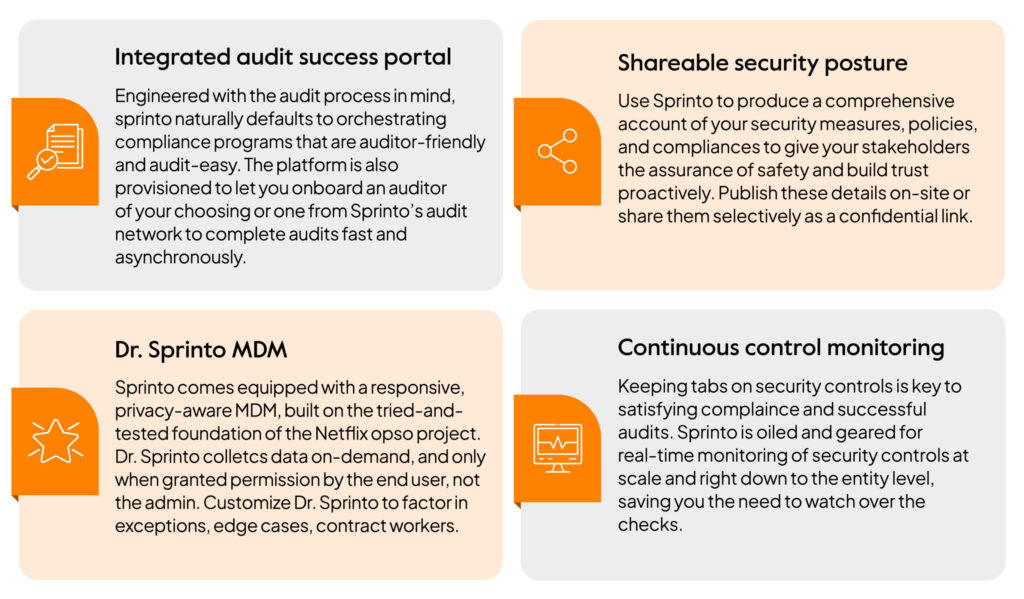
Beyond evidence collection, Sprinto:
- Provides auditor-ready policy templates you can customize and publish in minutes
- Tracks security training and certification completion automatically
- Maps controls to SOC 2 criteria across the Trust Service Principles in a unified dashboard
- Creates a portal for auditors to access documentation and test results directly, cutting out the painful back-and-forth.
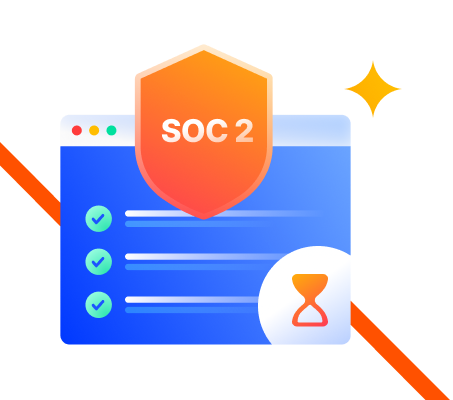
Automate and Fastrack with Sprinto.
Frequently asked questions
SOC 1 is about controls that could impact a client’s financial reporting. It’s for services like payroll processors or loan servicers. SOC 2, on the other hand, is about controls related to data protection and security, based on the Trust Services Criteria. It’s for any service that stores, processes, or handles customer data, like a SaaS or cloud hosting provider.
No, no law mandates a SOC 2 audit. It’s almost always a market-driven requirement. Your customers, especially larger enterprises, will demand a SOC 2 report as a condition of doing business with you to warrant that you can be trusted with their data.
Only independent, licensed Certified Public Accountant (CPA) firms that are recognized by the AICPA can perform a SOC 2 audit. Your friendly neighborhood IT consultant can’t do it; it must be a formal attestation from a licensed firm.
A SOC 2 audit needs to be performed annually. A report is just a snapshot in time (or over a period), so to provide continuous assurance to your customers, you need to renew your audit every year to prove your controls are still effective.
Failing means the auditor issues a “qualified” or “adverse” opinion in your final report. This report is still shared with customers, but it will have a big red flag indicating that specific controls failed their tests. This erodes customer trust and can potentially block sales. If you fail, you must fix the issues before the next audit cycle.
Pansy
Pansy is an ISC2 Certified in Cybersecurity content marketer with a background in Computer Science engineering. Lately, she has been exploring the world of marketing through the lens of GRC (Governance, risk & compliance) with Sprinto. When she’s not working, she’s either deeply engrossed in political fiction or honing her culinary skills. You may also find her sunbathing on a beach or hiking through a dense forest.
Explore more SOC 2 articles
SOC 2 Compliance Overview
SOC 2 Preparation and Documentation
SOC 2 Audit and
Reporting
SOC 2 Differences and Similarities
SOC 2 Updates & Management
SOC 2 Industry-Specific Applications
research & insights curated to help you earn a seat at the table.






